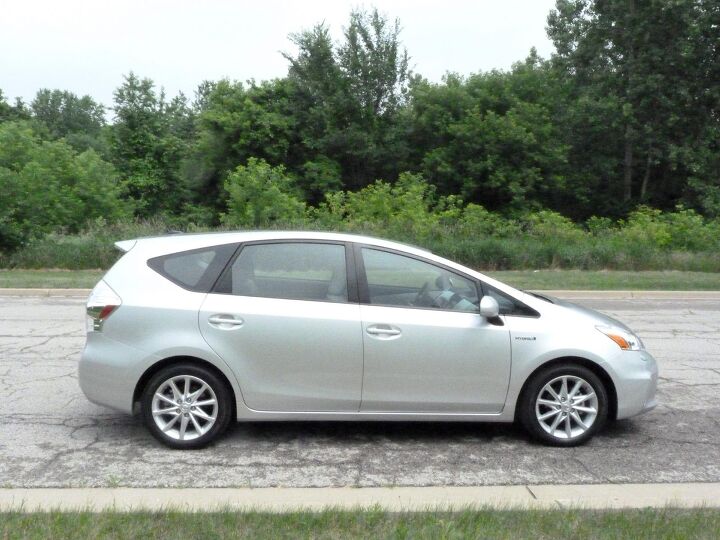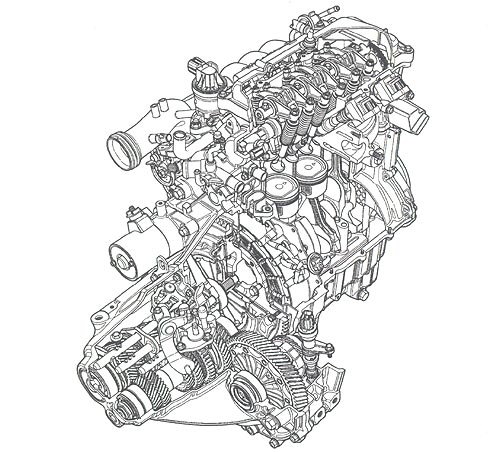#Hybrid
Review: 2011 Cadillac Escalade Platinum Hybrid
A couple months back, Cadillac gave me a bright red, three-ton, rollin’-on-22s, chrome-drenched, hybrid-electric, $88,140 luxury truck to drive while in Michigan for the Campaign To Prevent Gingervitis 24 Hours of LeMons. Since that time, the effort of attempting to write a meaningful review for this ridiculous-yet-amazing machine has caused my brain to develop a severe rod knock. Who is supposed to buy this thing? I asked myself. What can you do with it?
What's Wrong With This Picture: The New Efficiency Edition
The transition from exclusively gasoline-powered vehicles to the new panoply of permutations of gas and electric power has not been easy on the old emm-pee-gee. The imperfect-yet-universal (in the US market) measure of efficiency finds itself at a loss to compare an electric car’s efficiency with that of a gas-powered car, and completely falls apart as a relative measure of efficiency between plug-in-hybrids which use gas and electricity in different ways (see the ongoing battles over the Chevy Volt’s efficiency). Into the breach have stepped several challengers to the emm-pee-gee’s supremacy, including the weak MPGe (which was responsible for the Volt’s disastrous “230 MPG” introduction), and the “Kilowatt-hours per 100 miles” measure championed by Motor Trend in a rare display of admirable pointy-headedness. But the Gordian contradiction of efficiency measures is that they must be both accurate and easy-to-understand… and if the MPG’s history tells us anything, it should probably err on the side of the latter prerogative.
Was, Ihr Volt Ampera? Vergessen Es!
End of the year, Europeans can delight in the Made in America Opel Ampera, which is a rebadged and slightly reskinned (see picture) Volt. But don’t rush to your friendly Opel dealer to put in your pre-order: The Ampera is already sold out.
Quote Of The Day: The Obsolescence Of Volt Edition
Fortune [ via CNN]’s Alex Taylor III is clearly as disappointed as I was with Joe Nocera’s toothless, vaguely pro-Volt piece in last Sunday’s NY Times, and he’s riled up enough about it to lay down a savage call-out the Volt hype machine. In fact, it’s a less scientific, less comprehensive (and, by virtue of the passage of time, less speculative) version of a piece my father wrote in 2008, comparing the then-undelivered Volt with the also unlaunched 3rd gen Prius and Plug-In Prius. Taylor’s foil for the Volt is the plug-in Prius, which now arrives in less than a year, and in the eyes of the longtime industry writer, the contrast is stark:
Volt enthusiasts like to recite the fact that the Volt can go 35 miles on battery-power and then shift seamlessly into gasoline-engine mode, saving on gas and reducing emissions of greenhouse gases. It is an impressive technological improvement but one that is already obsolete.
Here’s why:
Review: 2012 Toyota Prius V
Brand extensions aren’t common in the auto industry, perhaps because they rarely (if ever) succeed. Chrysler and Oldsmobile hyperextended the LeBaron and Cutlass brands, respectively, into oblivion. But Toyota has struggled as much as anyone to sell hybrids that aren’t named Prius, so it will now attempt to sell additional models under that highly successful nameplate. First up: the Prius v (with the lowercase v for “versatile”). How far and how effectively does a second model extend the reach of the brand?
While The Pope Goes Green, Mortals Get Gas
The Pope is working on his green creds. When the German Pope Benedikt XVI will come to Germany in September, he will wave at the faithful from a plug-in hybrid. Made in Germany, of course. Mercedes is putting the finishing touches on a new popemobile. Based on the new M-Klasse, it is powered by a 60 hp hybrid module. The lithium io battery will supposedly be rechargeable in 60 minute, allowing the Pope to travel for 30 kilometers (18.6 miles) on heavenly electrical power alone. Once depleted, the ICE kicks in.
Why no pure plug-in?
Reuters: Honda Fit Shuttle US-Bound
Plotting The Electrified Future: BCG Downgrades EV Penetration, Pacific Crest Offers Bear And Bull Cases
Reuters reports that Boston Consulting Group has revised its projections for EV market penetration downwards, concluding that plug-in electric vehicles (including EREV and PHEV models) will make up no more than five percent of the US market by 2020. And ironically, the recent increases in gas prices have actually driven the estimate downwards, as Xavier Mosquet, the global head of the group’s autos practice, tells The WSJ [sub]
Electric cars will undoubtedly play an increasingly large role in many countries’ plans in the decades ahead as energy independence and environmental concerns intensify, but they will gain only modest ground to 2020. Gas- and diesel-powered vehicles are improving faster than expected and will continue to dominate the global landscape.
Hammer Time: The Boss Killed My Car
Your worst nightmare. A pleasant drive along a yawning rural two-laner is met by a sudden ‘jolt!’ You quickly take your foot off the accelerator. Was it a transmission shudder? A miss in the engine? Some gravitational push from a UFO? After a couple of mini-jolts it looks like problem number one. You do what you can to not stress the tranny. But it gets worse and worse until ‘jolt!’ ‘JOLT!’ ‘Veeeee!!!!’ The engine spins over to the high rpm’s with nothing left to propel it. The tranny is toast… and now the fun begins.
Suzuki To Sell Plug-In Hybrid Swift
Suzuki will finally relent and will offer a plug-in hybrid version of its bestselling Swift hatchback. A lithium-ion battery will power the car for the first 30km (18.6 miles), then a gasoline engine will produce the juice, says The Nikkei [sub].
Chevy Drops Volt Price (And Standard Nav), Rolls Out 50-State Sales For 2012
GM has announced details for the 2012 Model Year Chevrolet Volt, and for the second year of production The General is already addressing the Volt’s most controversial feature: its high price. The base MSRP for the Volt will drop from $41,000 to $39,995 for the 2012 year of production, an accomplishment that GM explains
is possible in part because of a wider range of options and configurations that come with the expansion of Volt production for sale nationally.
Wider range of options and configurations? According to the Detroit News, this means navigation and a Bose speakers are no longer standard features on the base-price Volt, but that seven options configurations are now available compared to the 2011’s three. And, on the other end of the pricing equation, the Volt’s fully-loaded price has increased to $46,265 from the $44,278 that Chevy’s configurator tops out at for a loaded 2011. Keyless access with passive locking is the only new standard feature for 2012. With more choices and a slightly lower price of entry, GM is clearly trying to move the Volt away from the “novelty” image that CEO Dan Akerson referenced earlier this week, as it ramps up Volt production for 60,000 units next year. But until the Volt’s price starts dropping without simply offering a less-contented version, the road to mass sales will continue to be a tough one.
Ford Cancels 7-Passenger C-Max For US, Now Coming As Hybrid/Plug-In Only
When Ford showed the world its new crop of compact-based cars and MPVs at January’s Detroit Auto Show, it announced that its C-Max compact MPV would be coming to the US in 7-passenger Grand C-Max form. But in a strangely prophetic turn of events (see video above), the 7-passenger model refused to show up. Now, according to Ford, the 7-passenger Grand C-Max won’t be coming to the US… instead the 5-passenger version will be sold as a dedicated hybrid model with a plug-in option. Why? Because it’s big in Europe… and because “One Ford.” Hit the jump for Ford’s explanation, and then wonder along with us: seriously, why not sell the 7-seat version too?
What's Wrong With This Picture: Fuel Prices Versus Hybrid Sales Edition
The Alliance of Automobile Manufacturers is taking to the internet ahead of a forthcoming increase in 2017-2025 CAFE standards, with a website called “ Consumers and Fuel Economy.” There you can find, among other things, this graph detailing the relationship between hybrid sales and fuel prices over the last three… summers? Did the fall and winter data not support the AAM’s goals? If so, and this graph has been constructed for maximum impact, it’s hardly a wildly convincing slice of data… or is it?
Babe Magnets Gone Hybrid: We Pickin Up Their Chicks In Our TOYOTA PRIUS
I’m just beginning to figure out that Twitter thing, and there it was:
“ ToyotaPR Scott Brownlee RT @YouTubeLMAO: @ToyotaPR Made this Hybrid Music Video for Toyota. http://youtu.be/8H-yUQZ9uqM
Say what?
UN: Recycling Rates For Key Green Car Elements Below 1%
A report by UNEP [ PDF here], the UN’s environmental body, finds that recycling rates for some of the key ingredients in EV and Hybrid cars are woefully low. The chart above shows “functional recycling rates” for 60 metals, and the rate for such key elements in the production of EV and Hybrid batteries and magnets as Lithium, Vanadium, Lanthanum, Neodymium, Dysprosium, all have recycling rates of 1% or lower. Not only do many of these elements have the potential for creating ecological damage, but many (especially the so-called “rare earth elements”) are considered relatively scarce…. and not recycling exacerbates both of these issues. But, notes the report, the complex fusion of elements used in both batteries and EV magnets could present huge challenges in ever improving these rates of recycling.
Where relatively high EOL-RR [End Of Life Rates of Recycling] are derived, the impression might be given that the metals in question are being used more efficiently than those with lower rates. In reality, rates tend to reflect the degree to which materials are used in large amounts in easily recoverable applications (e. g., lead in batteries, steel in auto- mobiles), or where high value is present (e. g., gold in electronics). In contrast, where materials are used in small quantities in complex products (e. g., tantalum in electronics), or where the economic value is at present not very high, recycling is technically much more challenging.
Hat Tip: Auto123
























Recent Comments